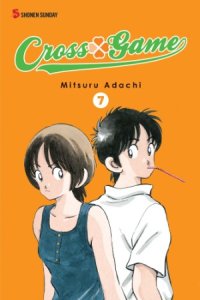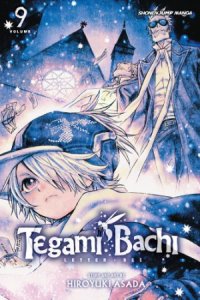RIGHT TURN ONLY!!
X Game
by Carlo Santos,

As everyone has been talking about, Anime Expo is going to be an even bigger circus than usual this year with the X-Games happening right next door. And adding to the chaos is Comic-Con arriving a week earlier than usual. Are they purposely trying to stress me out this summer? We shall see!
CAGE OF EDEN

Vol. 5
(by Yoshinobu Yamada, Kodansha Comics, $10.99)
FROM THE BACK COVER:
"As Akira and his team continue looking for their lost friends in the jungle, they must confront the fact that one of them is a serial killer. If they aren't careful they could all be his next victims! The adventure continues in this harrowing new volume!"
EVIDENCE FOR:
As expected, the suspense just doesn't let up in the latest Cage of Eden. Every time the kids seem to have escaped one calamity—deranged serial killer, hungry prehistoric beasts, flash floods—another one pops up right after. It's that sense of constant peril that makes each chapter so addictive. Then the story takes an even more surprising twist in the book's second half, when Akira and his comrades stumble upon another faction of students building their own community. Now the battle isn't just human vs. wilderness—it's human vs. human, and we all know that's only going to raise tensions even higher. The sparks really start flying when a violent attack causes the students to turn on each other ... and then Akira uses a clever ruse to find the true villains in their midst. Lies, betrayal, and social disorder: how can anyone not get hooked on a story like that? Meanwhile, meticulous background art and carefully drawn creatures add to the ambience of the island—a very untamed and threatening ambience. Dramatic action poses and intense facial expressions also carry the last several pages to a powerful ending.
EVIDENCE AGAINST:
Despite all the white-knuckled escapes and nonstop action, Cage of Eden still feels like a work that fails to achieve its full potential. When Akira and company are trapped in the cave, trying to find their way out, we never get a full idea of how frightening and oppressive the cave feels—instead, it's the characters who occupy most of the panels with crowded close-up shots. Without shadowy views of the cave to give a sense of claustrophobia, it feels as if the kids are just running around with rocky walls in the background. The cave segment also gets confusing due to shifting points of view—different groups of characters get separated, and it's hard keeping track of everyone. The conflict between Akira's group and the other student faction is easier to understand, but when they use a "clever ruse" to uncover the traitors among them, it's telegraphed so far in advance that it no longer feels clever by the time it happens. The artwork has a lot of spotty moments as well, from questionable anatomy and perspective to fanservice popping up at the most inopportune times.
FINAL VERDICT:
It tries hard to be dramatic all the time, but the story and art just aren't fine-tuned enough to really amaze the reader. This one's a C as far as survival adventures go.
CROSS GAME

Vol. 7
(by Mitsuru Adachi, Viz Media, $14.99)
FROM THE BACK COVER:
"With his final summer in high school approaching, Ko and the rest of the team are right in the thick of the regionals to qualify for Koshien. They manage a win in their first game, but the next round pits them against Kurokoma, led by none other than Seishu's infamous former coach, Daimon. Seishu is cautious because they know Daimon would really hate to lose to the 'Portables' twice. And as the team battles its way toward Koshien, Akane Takigawa is dealt a blow to her health and is hospitalized."
EVIDENCE FOR:
The best thing about this volume of Cross Game is the return of actual baseball after a sleepy Volume 6. But even with the excitement of the Koshien Tournament, the series still maintains its perfect balance of genres, blending slice-of-life drama and humor with sporting action. While the Seishu team's on-field heroics are a thrill to behold, it's the stuff in between that gives the characters their third dimension: flashbacks and drama as former teammates cross paths, high school kids musing on life and friendships, even a little bit of poking fun at the media and bandwagon fans. And just as the drama escalates for Ko with each successive game, so it goes for Akane and her time at the hospital, leading up to the perfect volume-ending cliffhanger. Skilled, confident artwork brings each game to life with freeze-frame poses and bursts of action, along with the realism of carefully detailed backgrounds. The character designs, although simple, are charming and instantly identifiable; even on the field the players are easy to pick out. Page layouts also follow the path of simplicity, with straight-ahead views and lots of wordless panels setting the tone of a laid-back yet absorbing story.
EVIDENCE AGAINST:
There is such a thing as being too laid-back, and it really starts to show in this volume, with some of the game action so lazily drawn as to be incomprehensible. It's as if Adachi is picking baseball scenes at random: here's a guy batting, here's a guy catching, here's a pitch ... and then Seishu wins the game. Wait, what? Blame it on a storyline that is trying to compress Seishu's trip to the finals, which means passing through games where nothing exciting happens and quickly summarizing them. Thus you get the vague action mentioned above, AND it pads out the story unnecessarily because the game wasn't important in the first place. Of course, a few more words of explanation—or rather, narration—would surely clear things up. The slice-of-life side also suffers from unnecessary padding, with idle chatter and tired old jokes eating up a lot of pages. Yes, we know Azuma's older brother wants to marry the eldest Tsukishima sister if Seishu wins, but he really should give it a rest. As expected, these idle moments also result in some of the least interesting visuals in the series.
FINAL VERDICT:
Yes, there's a bit of trudging through unimportant games and unimportant conversation, but this volume's moments of drama and triumph are still strong enough to earn it a B.
KUROSAGI CORPSE DELIVERY SERVICE

Vol. 12
(by Eiji Otsuka and Housui Yamazaki, Dark Horse, $11.99)
FROM THE BACK COVER:
"Second Death! Two bodies found in the woods—one not quite departed, the other horribly mutilated—lead The Kurosagi Corpse Delivery Service to investigate a private online community. The virtual world offers you the chance to do all kinds of things in simulation that you couldn't do in life ... but are you sure everyone playing is still alive?"
EVIDENCE FOR:
How does Eiji Otsuka do it? No, seriously, how does he keep topping himself with bizarre ideas that mix everyday life with the occult? This volume features three complete storylines, each one more mind-bending than the last. The first feeds off the simple fear of creepy internet things, the second uses morbid humor (literally) to expose the seedy side of the entertainment industry, and the third ... well, life-size dolls are creepy enough by themselves, but throw a North Korean conspiracy on top of that, and wow. But Otsuka isn't just tinkering with high-concept plot devices here—he also takes time to develop appealing characters that pull us into their story, most notably the ill-fated comedy duo in the middle chapters. Don't get too attached, though, because at any moment artist Housui Yamazaki could pull out one of those gruesome, fully detailed scenes that'll make your head snap back. The precise, clean-lined artwork also contrasts strongly against the "dirty" subject matter, making it all the more striking when corpses reanimate or bodies are sliced apart. And amidst the gore, the series still finds ways to poke satirical fun at modern society.
EVIDENCE AGAINST:
Yamazaki's semi-realistic style gives the series a very distinct look—and it also runs the risk of boring readers to death. There are long stretches of story where Kurosagi Corpse Delivery Service offers little in the way of visuals, because the characters are simply standing still, chatting with each other in generic office buildings or on city streets. The adherence to realism also holds the series back during big action scenes: when the characters escape a raging fire in the later chapters, they look like they're strolling through a series of guided waypoints instead of fighting for their lives. On the story side, the principal members of the Kurosagi gang get shafted once again as Otsuka places far more emphasis on the one-off characters and situations in each tale. It gets so bad that at one point, two of them are mentioned as being away on an errand because there's no role for them in the story. Part of the series' appeal comes from the chemistry of the ensemble cast—so sending them off to the sidelines makes it no fun.
FINAL VERDICT:
Fortunately, the stories are creative enough (and the artwork skilled enough) to overcome occasional stretches of boredom and achieve a B+.
TEGAMI BACHI: LETTER BEE

Vol. 9
(by Hiroyuki Asada, Viz Media, $9.99)
FROM THE BACK COVER:
"Amberground is locked in darkness. A man-made star casts only a dim light over the land. The pitch-black wilderness is infested with Gaichuu—colossal insects with metal exoskeletons. The Gaichuu make travel between the cities of Amberground extremely dangerous. But thankfully the Letter Bees, a brave corps of messengers, risk their lives in order to keep the hearts of Amberground connected.
Lag's hero, Gauche Suede, has returned to the Beehive—but not in the way Lag had hoped. While Gauche lies injured and unconscious, two mysterious government operatives show up to take him away, arousing the suspicions of the Beehive staff. What is the Amberground government trying to hide from the Letter Bees?"
EVIDENCE FOR:
Just when you thought Tegami-bachi had gone irrevocably down the path of dark and serious ... it suddenly switches back to Lag's letter-delivering adventures! Yes, the second half of this volume is an odd surprise, but a pleasant one as the series revisits what made the early chapters so appealing. Lag's latest assignment leads to a tale of lost love, with all the heartache that entails—but some comedic action as well, as the villain in this story turns out to be a greedy, bumbling family of aristocrats. But don't think Hiroyuki Asada has forgotten all about the drama he's been building up: this volume marks the debut of Amberground's government agents, whose shocking actions generate plenty of intrigue about the future of the Letter Bee organization and the rebels of Reverse!?. These agents also reveal Asada's versatility as a character designer, bearing neither the cuteness of the younger Bees nor the sleek beauty of the Beehive's staff, but rather a rugged manliness—with fighting moves to match. The backgrounds, too, are striking and beautiful as ever, ranging from Victorian-style buildings to the open, star-studded landscapes that set the stage for Lag's journeys.
EVIDENCE AGAINST:
"What's next for Gauche Suede and Reverse!?" Surely that was the question on everyone's minds coming out of the last volume ... yet this one offers no answers. Lag's latest delivery is a charming little story in itself, but comes at a bad time; all it does is get in the way of the main storyline right when it ought to be moving forward. Meanwhile, the events that do relate to the Letter Bees vs. Reverse!? situation consist mostly of running in place. The government agents arrive, which is a start, but then half a chapter is wasted on a silly mock-battle between them and Lag's sidekick Niche. Speaking of which, the reunion between Lag and Niche is another plot point that takes up too much time—Asada drums up an entire chapter about Lag going on a middle-of-nowhere delivery just so he can get Niche back into the picture. At least the dynamic action scenes make these pointless moments entertaining—but the busy linework and amount of detail that goes into each panel can look cluttered, too. Even sound effects and speech bubbles get in the way.
FINAL VERDICT:
The second half features a pleasant return to stand-alone tales of human drama, but the overall storyline suffers as a result—a volume of unfulfilled potential that gets a C+.
X (3-in-1 edition)

Vol. 2
(by CLAMP, Viz Media, $19.99)
FROM THE BACK COVER:
"Hinoto, Japan's greatest seer, has foretold the end of the world. At the center of her prophecy is Kamui Shiro, a young man who possesses tremendous arcane powers. Scarred by a traumatic past and struggling under the burden of his destiny, he is driven by his desire to protect the two people who are the most important to him: his childhood friends Fuma and Kotori.
However, in the aftermath of their father's violent death, the quiet, dependable Fuma begins to act in a strange and worrying manner. It gradually becomes clear that Fuma's fate is inextricably linked to Kamui's, and that both are somehow involved in the coming conflict. Now battle lines are being drawn, and other players in the prophecy are gathering around them: the 'Seven Angels,' who are fated to destroy the world, and the 'Seven Seals,' who are fated to try and save it."
EVIDENCE FOR:
Twenty years ago, CLAMP took on the end-of-the-world genre, and no one has been able to match the grandeur of X ever since. Every page is fantasy and surrealism cranked to the max, with swirling feathers and fountains of blood that are both gorgeous and terrifying. The series is at its visual peak during Kamui and Kotori's dream sequences, where they witness calamities so extreme—Tokyo laid to waste, the world splitting in two, human bodies falling apart—that one has to wonder if CLAMP pulled this out of their own worst nightmares. Surely no sane, rational mind could dream up the imagery found here. Then comes the equally surreal storyline, where visions of the past and future flesh out the details surrounding Kamui more than a straight 1-2-3 narrative ever could. There's lots of excitement to be had when new combatants on both sides face off, but the real thrill comes from the battle raging inside Kamui's head. Not only is he trying to figure out his destiny, but he's trying to figure out his unusually intimate relationship with Fuma ... which surely is the real reason some fans love X so much.
EVIDENCE AGAINST:
X speaks the language of emotion in powerful, eloquent terms—but is pretty much useless when it comes to logic. The story is all about showing off one dramatic moment after another, with little regard for actually filling out the plot (or the characters, for that matter). Aside from some cute little flashbacks about his childhood, what do we learn about Kamui in these 550 pages? It just keeps repeating that he is "the one fated to bring about the end of the world" ... which is exactly what they said in the first volume. Sometimes the script is even more dumbed-down than that: it's just various characters gasping "Kamui!" "Kamui..." "The Kamui" all the time. And if that's how poorly how the protagonist is treated, just imagine what becomes of the supporting cast: Fuma and Kotori are shoved to the side for a good two-thirds of the book, and when they do show up to interact with Kamui, it's always through contrived, melodramatic displays of friendship. Visually, the battles are also hard to follow—CLAMP's elaborate art excels in pin-up scenes, but is less effective when there's legitimate action going on.
FINAL VERDICT:
For all its flawed melodrama and over-the-top repetition, one can't help but admire the sheer beauty and epic scale of the Revelation According To CLAMP. That's why this is still worth a B.

APARTMENTS OF CALLE FELIZ (HAPPY END APARTMENT)

(by est em, Libre, ¥670, $8.95 online)
FROM THE BACK COVER:
"When his love found a new man, Luca found himself in need of a new place to live. He spotted a room for rent flyer that led to a bold offer from the landlord. The landlord and now roommate, Javi, guides Luca while composing a story for a novel. After observing the neighbors living in their apartment on the end of Calle Feliz, Luca writes a brand new story, committed to finding a happy ending for each person there. This is the story of how Luca, Javi and all their neighbors eventually find their own happy ending."
EVIDENCE FOR:
Take the artsy, "cool guy" characters of Natsume Ono, add the sensitive storytelling of Fumi Yoshinaga, and you might get something like Apartments of Calle Feliz, which explores male-male relationships without all the contrivances and melodrama of run-of-the-mill BL. This loosely connected volume of short stories features a surprising variety of pairings: in addition to the usual couples, there's a romantic threesome, and even a controversial May-December relationship. But these stories don't get by on sensationalism alone: there's real depth here, with the characters' words expressing true affection for each other. Poignant back-stories and symbolic gestures add sweetness to each relationship, more so than any forced overreactions would have. The final chapter, which puts Javi and Luca in the spotlight, also throws in a clever twist that may be the most emotionally affecting of all. The artwork shows just as much sophistication as the story, with character designs rendered in clean, simple lines yet still grounded in realism. The panels line up in neat, well-ordered rectangles, but vary enough in size to make each page interesting. Carefully chosen poses also show how one can express various shades of love without resorting to explicit imagery.
EVIDENCE AGAINST:
Although this is clearly BL of a higher standard, the short-story format holds it back—there's just not much room for building romantic rollercoasters when a full story has to fit within 30-odd pages. Potentially interesting plot points are left unexplored: Who was the guy that Luca used to live with? What happens after the old man reunites with his former adolescent lover? On top of that, the gimmick of Luca having to devise a "happy ending" each time means that the story structure must stick to a certain pattern, no matter how varied the characters or their situations are. By the time it gets to the Javi and Luca chapter, it feels as if we've only started getting to know the characters—like there ought to be a continuation to each subplot, showing the continuing lives of each apartment dweller. There's a sense of incompleteness in the art as well, most notably with the lack of backgrounds, but also in the sparse toning and shading that leaves too many areas of white. The extreme simplicity of some scenes also results in vague, hard-to-understand action.
FINAL VERDICT:
Although each of the short stories could easily have gone a little further, this is a definite must-read for BL fans who prefer their stories to have a more mature taste.

You can't keep A Good Man down! The highly prolific Eric P. is at it again, this time looking at a novel-turned-manga series. But don't forget, you're all invited to send in your own reviews on what's out there—everyone's voices are a part of Reader's Choice.
MAXIMUM RIDE

Vols. 1-5
(by James Patterson and Narae Lee, Yen Press, $12.99 ea.)
Maximum Ride, the title character, and five other kids, who through scientific experiments at a lab called the School, were genetically engineered into human/bird hybrids, are a Flock of winged super-strong and super-hungry people. They escape and try to live on their own, giving themselves unique names like Fang (the quiet guy), Angel (the little girl), Nudge (the talkaholic girl), Iggy (the blind guy) and Gasman (the young explosives fanatic). But the School hunts them down, sending out human/wolf hybrids called Erasers after them, and thus Max and her Flock keep going on the run, or rather the fly, all across the United States. In their travels they gain special powers unique to each of them, and learn of dark secrets and revelations of a global organization that ran the School, called Itex, which has plans for world domination. Max receives messages from the mysterious Voice in her mind that prophesizes her being the world's savior, yet unlike most typical heroes, rather than learn to follow the Voice's guidance Max follows her own path in fighting to save everything important to her.
This manga is based on the sci-fi/fantasy novel series by James Patterson. It had creative ideas with suspenseful action going for it—but it still had its problems. For one, it was narratively uneven. It's mostly from Max's first-person perspective, but without warning it switches gears to third-person when the next chapter doesn't revolve around her, making for an awkward shift in writing style and tone. Another is that James Patterson seemed to be trying too hard to make his characters sound hip and cool with their consistent tough-talking and extensive witty remarks. Some of the dialogue gets so over the top, one begins to wonder, "Okay, who talks like this, seriously?" Either that or Mr. Patterson was trying too hard to write the novels like a teenager would write them. Most of the time the plot even sounds like something a teenager would come up with.
In graphic novel format, Max's exhausting sarcastic narrative is done away with, leaving the images and the dialogue to tell the story. Much of the superfluous dialogue is trimmed and toned down, leaving just the right amount that's true to the characters, the story and maintain its sense of humor. Seeing how the story gets faithfully adapted from print to comic, it's like Maximum Ride was made to be a manga. Each of the characters are even given traditional but appropriate manga-styled designs. Max is the beautiful, blond-haired jacketed heroine, two of the guys in the Flock her age are bishie, while the three younger kids get more of a moe look. And the artist brings each of them to vibrant life, detailing the action as well as the angelic grace of the Flock characters in flight.
Maximum Ride is nothing intellectually-driven. All it is meant to be and succeeds at is fun, entertaining reading, no matter how mindless it gets (how on earth do they tuck in their massive wings beneath their clothing?). And as it turns out this series just works better and makes more sense as a manga than it does a novel.
Is there a hidden gem of manga you'd like to reveal to the world? Is there a piece of garbage that deserves to be bashed in public? Or is there a title that didn't get a fair grade here, and you want to set the record straight?
Now's YOUR chance to be the reviewer! Write a review of about 300-400 words (a little more or less is fine) and include:
- your name.
- Title of manga (and volume no., if applicable)
- Author/Artist
- Publisher
- Briefly describe the story, then explain why this manga is great, terrible, or in between. Be objective, but also be entertaining.
Then send it in to rtoreaders (at) gmail (dot) com (plain text format preferred). One review will be selected out of all the submissions and will be published in the next column. All types of manga and manga-inspired comickry are accepted, from past and present, from Japan and beyond—what matters is that it's the Reader's Choice! NOTE: Submissions may be edited for formatting and grammar.
discuss this in the forum (8 posts) |